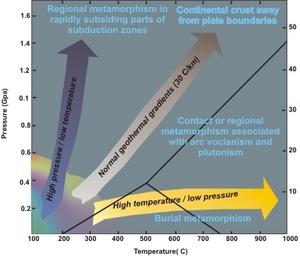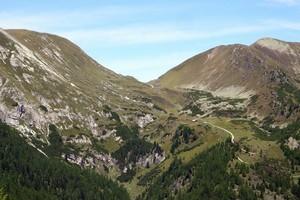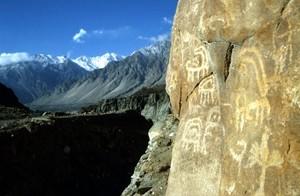Regional Metamorphism
Orogenic metamorphism terranes. Alps, Radenthein Nockberge, Austria. Convergence of lithosphere plates
Image Credit: Dorothee Mertmann
Orogenic metamorphism terranes. Himalayas. Pakistan
Image Credit: Dorothee Mertmann
Regional metamorphism includes any metamorphic process that occurs over a large region. It is therefore the most widespread and common type of metamorphism. There are three basic types of regional metamorphism, namely burial, ocean-ridge and the orogenic regional metamorphism.
Burial metamorphism
Burial metamorphism mostly affects sedimentary strata in sedimentary basins as a result of compaction due to burial of sediments by overlying sediments. As temperature increases with depth, both p and T contribute to metamorphism. Metamorphism occurs along a more-or-less stable geothermal gradient; the resulting metamorphic mineral assemblages are characterized by low recrystallization temperatures and an absence or reduced presence of deformational features. Burial metamorphism of sedimentary rocks is only loosely related to orogenic processes at plate boundaries ("anorogenic") and may also occur in plate interiors.
Ocean-ridge metamorphism
Ocean-ridge metamorphism takes place at mid-oceanic ridges in response to sea floor spreading. The plate tectonic setting is therefore characterized by a divergent plate boundary regime. This metamorphism is attributed to the high heat flow and intense fluid circulation that occurs along oceanic ridges. Resulting metamorphic rocks usually include greenstones and amphibolites, i.e., the low- and medium-grade metamorphic equivalents of oceanic basalt. In order to convert basalt into greenstone or amphibolites, H2O must be introduced into the rocks, which means that hydrothermal circulation of fluids through the oceanic crust is required.
Orogenic metamorphism
Orogenic metamorphism is the most common tye of metamorphism. It commonly occurs in island arcs and near continental margins because orogenic belts typically form at convergent plates boundaries. Understanding orogenic metamorphism leads to the understanding of the thermal, burial and erosion cycle of any orogeny.
There are three main characteristics of such a type of metamorphism. First, there are a variety of orogenic processes which take place at different convergent plate boundaries. These include, among others, geotectonic settings, oceanic island arc, ocean-continent, and continent-continent collisions, each of which has distinctive thermal, burial and erosional profiles. Second, pre-collisional geometries of the continental margin may be rather diverse, ranging form wide, passive, "Atlantic-type" margin to small back-arc extensional basins. Finally, the nature and duration of interaction between crust and mantle determines the amount and timing of orogenic heat flow, intrusive events with associated heat advection into the crust, and exhumation rates. All these factors are likely to differ from one orogenic belt to the next. Classic orogneic metamorphic provinces include the Alps of central Europe, the Appalachian Mountains of eastern North America and the Andes of western South America.
Orogenic Metamorphism involves broadly concurrent deformation, resulting from contractional stress during convergence of lithospheric plates in the subduction zone and recrystallization resulting from p-T increases in the thickened crust. Increased temperatures in orogens are created because geotherms adjust to the crust that is gradually thickened by contractional overthrusts and folds, magmatic underplating and stacking of volcanic deposits. Temperature is generally sufficiently high in the lower crust to cause partial melting and generation of calc – alkaline magmas. These will ascend into the shallow crust and solidify as granitoid plutons. Isostatic uplift and subsequent erosion during and following orogeny may expose the crustal welt of metamorphic and plutonic rocks.
Orogens typically evolve over hundreds of millions of years and experience more or less discrete pulses of deformation or tectonic events related to changes in character of converging oceanic plates and their rates of convergence. Heating of the crustal welt may accompany these pulses or occur sometime else, but may also occur in distinct episodes. Consequently, regional terranes in orogens typically evolve through multiple episodes of deformation and recrystallization, each of these events lasting several million years.

Metamorphism and geothermal gradient. The sequence of metamorphic facies observed in any metamorphic terrain depends on the geothermal gradient. The temperature-pressure diagram shows the distribution of three three major types of metamorphic facies series.
Contact Facies Series (very low-P); Buchan or Abukuma Facies Series (low-P regional) ; Barrovian Facies Series (medium-P regional); Sanbagawa Facies Series (high-P, moderate-T); Franciscan Facies Series (high-P, low T).
The high p/T series typically occurs in subduction zones where “normal” isotherms are depressed by the subduction of cool lithosphere faster than it can equilibrate thermally
The medium p/T series is characteristic of common orogenic belts (Barrovian type).
The low p/T series is characteristic of high-heat-flow orogenic belts (Buchan or Abukuma type), rift areas, or contact metamorphism.
Thus, if we know the facies of metamorphic rocks in a region, we can determine what the geothermal gradient must have been at the time the metamorphism occurred. This is the relationship between geothermal gradient and metamorphism.
Source: MBG redrawn and adapted from Winter (2001) and Nelson (2004).

